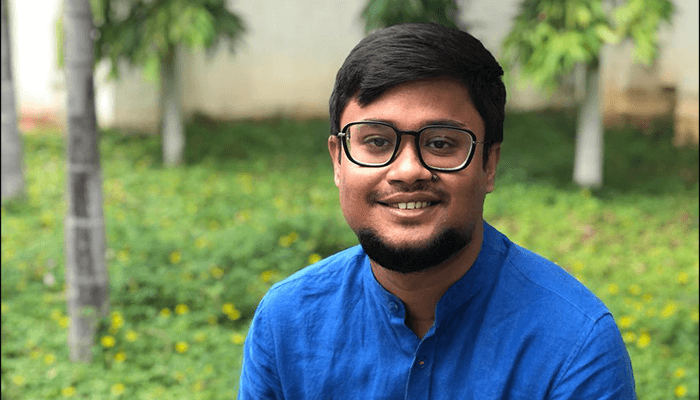Something very magical would happen, every time Quantum computing theorist Shantanav Chakraborty picked up a book. Whether it was Ramanujan’s Lost Notebook, Penrose’s Emperor’s New Mind, Gorky’s Mother or Lorca’s poetry collection, it was destined to fire his imagination and reshape his world.
Dr. Shantanav Chakraborty was always interested in physics and fundamental sciences for as long as he can remember. With a background in computer science, it was a book on quantum physics that made him realize that quantum computing was the place he wanted to be.
“Quantum science and technology is quite big globally and in India too, the field is beginning to take off. We still have some catching up to do if we are to compete with the major global players.”, says Dr. Chakraborty, Assistant Professor at IIITH’s Centre for Security, Theory and Algorithmic Research (CSTAR) and the newly formed Centre for Quantum Science and Technology (CQST).
All that jazz about Quantum
The best way to understand quantum computing is by looking at computing devices around us today. A Computer is nothing but an exotic physics experiment, explains the professor. As you look deeper, past the circuits and into the transistors, this is where you see tiny electrons moving, generating binary signals that form the fundamental unit of computation. Although electrons are microscopic objects, the physics driving today’s computers, is the physics of macroscopic objects. However, quantum mechanics, the physics of subatomic particles like an electron, is a more complete description of our world. “The field that I work in, essentially takes the advantage of quantum mechanics to do computing. In particular, my research explores ways to harness the properties of quantum physics to perform meaningful computational tasks.”
What applications does the theoretical work that they do, have in real life? Dr. Chakraborty cites the example of how Shor’s Algorithm can find the prime factors of a large number efficiently. Prime factorization is widely considered to be a hard problem for classical machines and forms the basis of the RSA algorithm that is used to encrypt our data. “A full-scale quantum computer would break our cryptosystems”, he said. He adds that the potential applications of quantum computers are numerous, ranging from simulation of new molecules and materials to providing advantages in performing machine learning tasks.

Tragedy and a quantum leap away from computational biology
Born and educated in Calcutta, Dr. Chakraborty attended an English medium school; seen as `aspirational’ for upper-caste families in our country, especially the middle-class, he says, tongue-in-cheek. The B. Tech in IT from WBUT (2007-11), would spend a year and a half at the Applied Statistics Unit, Indian Statistical Institute (ISI) during his undergraduate, where he worked on computational biology, specifically on the statistical analysis of olfactory receptors and their genomic descriptions.
He moved to IIT Jodhpur for his M. Tech in Computer Science and Engineering (2011–13). His interest in quantum theory was rekindled when he read Emperor’s New Mind by Roger Penrose. Thus began his journey on quantum algorithms, a happy marriage of his two interests: theoretical computer science and quantum mechanics.
It was not a linear journey to Lisbon for the young scholar. In 2012, due to the untimely death of his father, he opted to stay in India for a year longer, a decision that was to be a blessing in disguise. He had at that point, already applied to positions based on his past research in computational biology. The change in circumstances allowed him to shift to Quantum algorithms. He was accepted by an international doctoral program, hosted by the University of Lisbon where he was affiliated with the Physics of Information and Quantum Technologies Group. The doctoral program comprised of a network of several universities which allowed Dr. Chakraborty to spend substantial time at QuSoft, CWI Amsterdam, as a visiting researcher. Following his PhD, he moved to Brussels, at the Centre for Quantum Information and Communication (QuIC), University libré de Bruxelles where he worked with Jérémie Roland as an FNRS postdoctoral researcher.
Quantum Theseus beats the minotaur faster
During his PhD, Dr. Chakraborty and his collaborators published a paper titled, ‘Spatial search by quantum walk is optimal for almost all graphs’ in Physical Review Letters, widely considered to be one of the best journals in Physics. It was selected as a highlight in the journal, reserved for only special letters that are of wide interest to the community. This result generated interest. ‘Quantum Theseus beats the minotaur faster’ was a popular summary based on their publication, which took inspiration from Greek mythology to emphasize the central result of their article: continuous-time quantum algorithms provide a substantial advantage in searching for an element on even random databases.
“If you are doing good work on quantum algorithms, you get noticed because the quantum algorithms community in the EU collaborates a lot with each other”, says Dr. Shantanav. Brussels, Paris, Amsterdam and Latvia are probably the best places for research in quantum algorithms in Europe, he observes. Both during his PhD and postdoc, he was part of the vibrant ecosystem where the discourse included a broad view of diverse fields from quantum information, foundations, optics, thermodynamics along with different aspects of quantum computing that challenged him to look at areas beyond his ken.
During his PhD, he also worked on exploring whether noise, generally the primary impediment for the realization of quantum technologies, can counter-intuitively, assist in the performance of quantum algorithms. The visit to CWI Amsterdam also proved to be quite fruitful as during his postdoc stint, Dr. Chakraborty and his collaborators at CWI developed a framework called block-encoding. “We showed that this framework can actually be applied to develop several new quantum algorithms”, he remarked. An important point of consideration while designing any quantum algorithm, is how to input data. “Several input models exist and quantum algorithms were designed specifically for each one of them. We showed that the block-encoding framework could unify most of these input models”. This also led them to develop new optimal quantum algorithms for solving linear systems, improving upon the results from 2009 by scientists at MIT. Dr. Chakraborty added, “Quantum linear systems is useful for several machine learning tasks and can be applied to develop quantum machine learning algorithms.”
Another work done in collaboration with Kyle Luh from Harvard and Jérémie Roland from Brussels, titled ‘How fast do quantum walks mix?’ has also grabbed attention after it was published in Physical Review Letters. “We provided upper bounds for how fast a quantum walk would converge to its limiting distribution on any network picked at random. To prove our results, we had used state-of-the art techniques from random matrix theory which is a topic of general interest across physics and computer science”, he explains.
Cupid strikes during the Pandemic
The best laid schemes of mice and men are often laid waste, as was the case with Dr. Chakraborty. This was in February 2020, when he was slated to return to Brussels after one of his annual trips to India. Destiny threw a googly, Covid hit and Cupid struck, all at the same time. He got into a serious relationship with Tanima, an old college friend, who was working in Hyderabad and thus opted to stay back in India. He decided to move to Hyderabad and while looking for a position, “somewhere close to where she works, IIIT Hyderabad came into the picture. I applied and luckily got in”, grins the Quantum Computing theorist.

“The good thing about IIITH is that if you have a new idea and you want to start something here, there’s very little pushback”, observes Dr. Chakraborty who teaches courses in quantum algorithms and automata theory at the institute.
Since joining IIITH in June last year, he has already worked on several problems. In a recent work, Dr. Chakraborty and his collaborators managed to prove that continuous-time quantum walks provide a quadratic speedup over their classical counterparts for finding marked vertices on any graph. “This was a problem that was open since 2004 and several attempts to prove such a result in this setting, had been futile. So, we are quite proud of this work”, Dr. Chakraborty remarks.
How do your two worlds not collide?
Growing up in Calcutta’s culture of debates and discussions, reading books, literature and poetry were early influences for the college topper who graduated with distinction from Lisbon. He was also the recipient of the TCS award for the `Best undergraduate thesis’ for his work at ISI, Kolkata.
It was Ramanujan’s Lost Notebook that got him interested in mathematics. “I make it a point to read paperbacks”, says the bibliophile who has a small yet cherished library of reading material. “I’m mindful of the fact that science and my research work is only one aspect of my life. There are other aspects that I also care about deeply such as how can we get rid of exploitative social relations. For example, in our country today we live in a caste-ridden, patriarchal society where fifty people own more wealth than the bottom fifty percent of the entire population. It’s hard not to be befuddled by this. I’m quite political in the sense that I want to contribute towards creating a better, more just society for everyone”.
During the pandemic lockdowns, Dr. Shantanav picked up a few chords of the guitar off YouTube videos. “I am quite fond of music. It also helps me while working. Even while doing involved mathematical calculations, I listen to music from a wide variety of genres just to be in the zone. This ranges from Bach and Chopin to Peete Seeger, Salil Chowdhury and Kabir Suman”, says the scholar who loves to put on his earphones and go for a run when he needs to clear his head. The Minotaur had better watch out. The Quantum Theseus is definitely going to figure out a way to catch him in the maze of tree-lined roads around the great banyan tree.



Next post